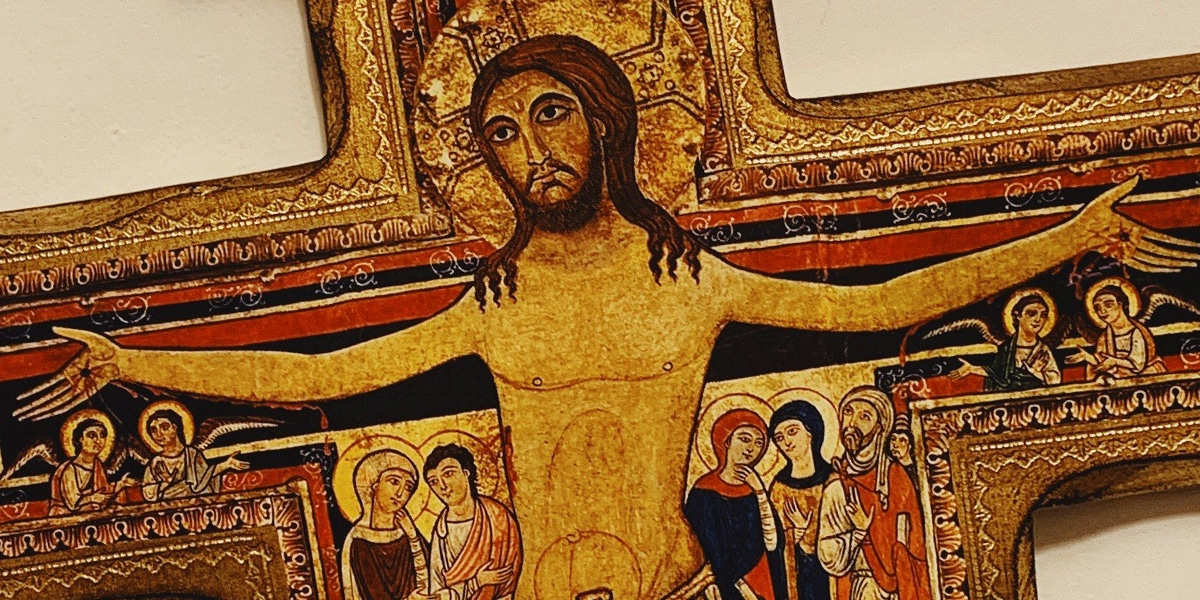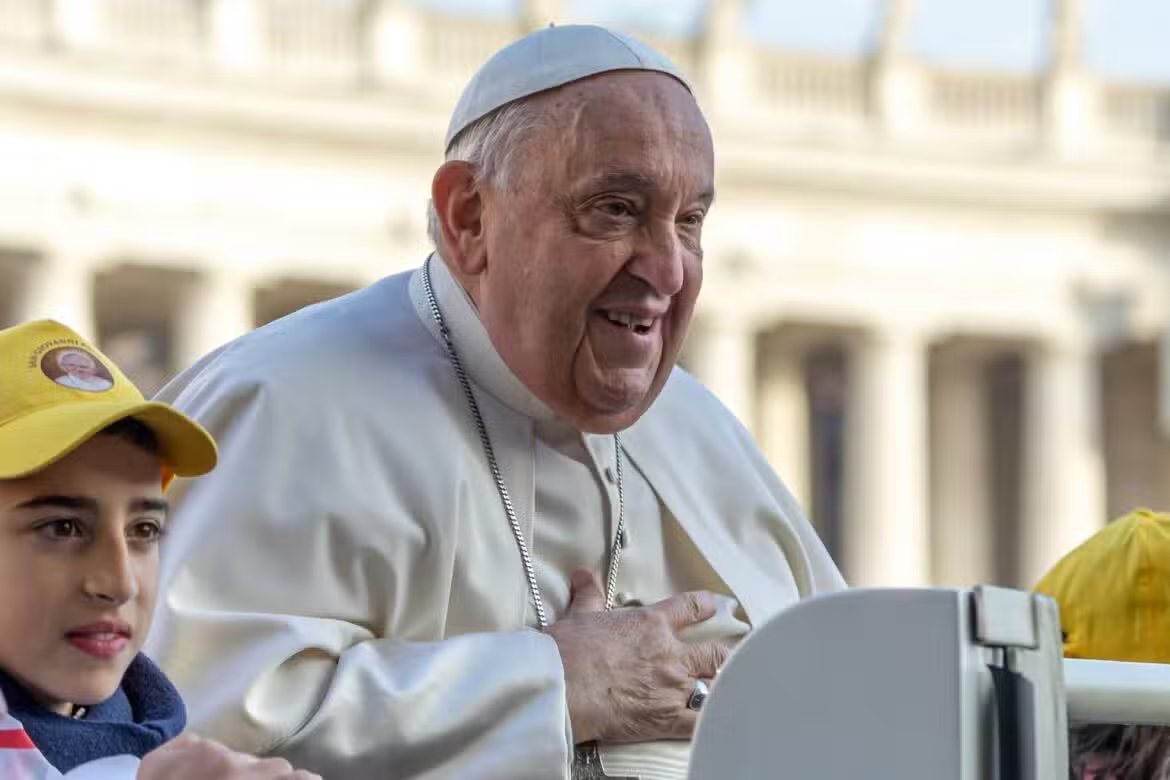At San Damiano, the Crucified Christ challenged Saint Francis to “go rebuild My house.” That task meant Francis had to transform himself first.
Every pilgrim who visits Assisi must make the short walk outside the city walls and spend time at the sanctuary of San Damiano. It is one of the most important places in the Franciscan story. The event most often repeated about this place is the encounter between Francis and the image of Christ Crucified who spoke to him and said: “Francis, go rebuild My house; as you see, it is all being destroyed.”
Thomas of Celano tells the whole story:
With his heart already completely changed—soon his body was also to be changed—he was walking one day by the church of San Damiano, which was abandoned by everyone and almost in ruins. Led by the Spirit he went in to pray and knelt down devoutly before the crucifix. He was shaken by unusual experiences and discovered that he was different from when he had entered. As soon as he had this feeling, there occurred something unheard of in previous ages: with the lips of the painting, the image of Christ crucified spoke to him. ‘Francis,’ it said, calling him by name, ‘go rebuild My house; as you see, it is all being destroyed.’
Francis was more than a little stunned, trembling, and stuttering like a man out of his senses. He prepared himself to obey and pulled himself together to carry out the command. He felt this mysterious change in himself, but he could not describe it. So it is better for us to remain silent about it too. From that time on, compassion for the Crucified was impressed into his holy soul. And we honestly believe the wounds of the sacred Passion were impressed deep in his heart, though not yet on his flesh.” —Second Life, #10, Francis of Assisi: Early Documents, Volume 2: The Founder, New City Press, p. 249
Herein begins the mystery of the cross in Francis’ life. At first he interpreted his experience in a literal manner, doing all he could to provide the means, with stones and mortar, to rebuild the physical structure of San Damiano, which actually was in ruins.
Although this may have been part of the intent of the revelation, Francis quickly realized that the rebuilding process had to include the transformation of his heart, his inner self. He would have to rebuild his inner self, and in doing so, discover his true identity. A simultaneous vocation unfolded: rebuilding the place and rebuilding his person.
Focused on Christ
How did Francis go about rebuilding his life? The process slowly unfolded from his gazing upon the Crucified Savior over time.
What were the steps? Saint Clare, a contemporary companion of Francis, described it best in her Second Letter to Agnes of Prague, when she wrote: “Gaze upon Christ, consider Christ, contemplate Christ, imitate Christ.” Those four steps would become the pathway into the discovery of a new heart, a new power and a new self.
I want to focus on just the last of these four directives: “imitate Christ.” That is the key to understanding what happened to Francis at San Damiano and the key to an effective rebuilding of one’s life.
To imitate relates to the word “image.” In our context here, it means I become the image upon whom I gaze. Francis would learn that his self-image, that is, his identity, was to become that of Christ on the cross. Both Francis and Clare must have spent countless hours contemplating this mystery. The change that would take place within Francis’ heart was imaged by what he gazed upon, and this new self would become his tool for renewing the house of God.
The Incarnation Is Key
The key to this is the Incarnation. In the Incarnation, God revealed to us who God is. The Incarnation showed us the face of God. But what does this image portray? What do we see? What Francis and Clare saw in the person of the Incarnate Christ was humility, poverty and charity. The most visible, tangible expression of this was the cross.
In the Incarnation, Francis saw that becoming human was the basis for humility. In embracing our humanness, Jesus did not cling to being God. This choice was the epitome of humility. In so choosing, Jesus could accept everything to which human nature is prone, even death. This image of Christ as seen on the cross became an essential component of Francis’ new self.
Like Jesus, humility for Francis meant not to cling to anything or appropriate any goods, titles, honors or position. It meant to be a servant to all, even inanimate creatures. It meant generosity of spirit and generosity of heart, the willingness to let all others be first. It meant obedience to all, being subject to all, just like Jesus, the Word made flesh, who did not cling to honor, status or power.

In recognizing his true self in this image, Francis embraced the essence of his being and the realization that he needed nothing else to give him worth.
The poverty Francis saw in the Crucified was the poverty of being a human creature. Although Jesus was God, he did not cling to this status. He didn’t hold on to it. In letting go of divinity, Jesus accepted the status of a human creature, being dependent, powerless, helpless and empty on his own.
This is the essence of poverty. Some call it poverty of being or ontological poverty. This true picture of humanity, modeled in the Incarnation, enabled Saint Paul to write that Jesus, “though he was in the form of God, did not regard equality with God as something to be exploited, but emptied himself, taking the form of a slave, being born in human likeness” (Philippians 2:6-7).
Jesus, as God, chose to become human, or poor, in order to reveal God’s self, which is love, and teach us our true identity. Again, this poverty of God was most visible by the fact of God’s Son on the cross. Here Jesus embraced powerlessness, emptiness and utter helplessness and opened himself to complete abandonment and trust in his Father. These were, and are, essential components of the human makeup.
All-Embracing Love
The other element that the image of Christ on the cross portrayed was that of charity, compassionate love. Jesus’ outstretched arms drew in all humanity, welcoming every creature into the embrace of God’s tender love through mercy, forgiveness and acceptance of all. This meant recognizing and accepting the worth and dignity of each one.
As we internalize the same, we are slowly transformed into the image of Jesus, which is the image of our true self.
The path into this discovery of self is the cross. The cross is a mirror. In seeing myself in that mirror, I see Christ Crucified, and in seeing Christ Crucified, I see my most authentic self. As I am transformed into that image, I become the person God has always intended me to be.
The distinguishing marks that identify me are the same I see in Jesus: poverty, humility and charity, which are identifying marks of the face of God. Paul’s words in Galatians 2:20 are then very fitting: “It is no longer I who live, but it is Christ who lives in me.” Then I am my true and genuine self.
This reflection is difficult to describe and I’m sure equally difficult to understand or accept. Yet it lies at the heart of Francis’ spirituality and mission. It also ties in most intimately with his experience before the San Damiano Crucifix and the invitation to rebuild the Church. It was a transformed heart, a transformed self, into the image of Christ that became the tools by which society, the Church and all life could be rebuilt.
As we embrace this process, we take a major step towards discovering who we are as a disciple of Christ; we are also well on the way to rebuilding our inner life and ultimately rebuilding the house of God.
God’s Project
How can we make this real and concrete? It seems to me we must come to a moment in life where, like Francis, we say: “This is what I want and desire with all my heart.” Once that is clear, then the rhythm of daily prayer is essential. We need to beg God for the kind of transformation of heart needed to have a dwelling place for humility and poverty and charity. We cannot achieve this on our own power. It is God’s project, God’s work, and only grace can make it happen.
The other arena is that of relationships, whether among friends, in the family, community life or one’s workplace. It is here that humility, poverty and compassionate charity are brought to life and nowhere else.
Francis’ biographers point out that, when people met up with Francis or heard him preach, it was not simply a question of listening to words of peace and joy. Nor were people merely persuaded to reflect upon reasons for forgiving each other, doing penance or thanking and praising God. Rather, they were confronted with these realities in the person of Francis. They were in the living presence of forgiveness, peace, faith and love, because Francis had integrated these values into his person by taking on the image of Christ on the cross.
Francis became conformed to the Crucified to such a degree that at the end of his life he appeared like the Crucified with the wounds of Christ engraved into his flesh. This would complete what began at San Damiano when “the wounds of the sacred Passion were impressed deep in his heart, though not yet on his flesh.”
Francis sought repeatedly for ways to encourage the brothers to give birth to these essentials, to strive for purity of heart, and thus give birth to Christ in their own lives. This is the transformation that must go hand in hand with all other endeavors in proclaiming the Kingdom of God. This is the inner rebuilding that gives life and spirit to any outward effort.
The image of Christ in Francis was very real, as we read in Celano:
The brothers who
lived with him know
that daily, constantly, talk of Jesus
was always on his lips,
sweet and pleasant conversations
about Him,
kind words full of love.
Out of the fullness of his heart
his mouth spoke.
So the spring of radiant love
that filled his heart within
gushed forth.
He was always with Jesus:
Jesus in his heart,
Jesus in his mouth,
Jesus in his ears,
Jesus in his eyes,
Jesus in his hands,
he bore Jesus always
in his whole body….
With amazing love he bore
in his heart and always held onto Christ Jesus and Him crucified.
—Francis of Assisi: Early Documents, Volume 1: The Saint, New City Press, p. 283-4








2 thoughts on “The Challenge of the San Damiano Cross”
Once when I was very young just after my first communion I had a spiritual encounter with Christ at the elevation of the Holy Eucharist. This reading brings back to mind the feeling that Christ was speaking to me that day. Thank you!
St. Francis’ and St. Clare’s Faith & Devotion to Jesus shows us clearly what is possible for Humanity.
All we have to do is simply stay focused on our Christ!